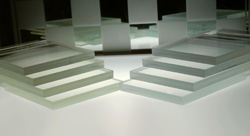Crystal clear safety thanks to DuPont™ SentryGlas®

Photo: DuPont
It also adds anti-intrusion security, sound reduction and protection from UV rays. Two common types of interlayer for laminated glass are films made of polyvinyl butyral, also called PVB, or DuPont™ SentryGlas® ionoplast.
The latter, developed especially for structural elements in architectural glazing, offers greater levels of clarity, is 5 times tougher and up to 100 times stiffer than PVB. Accordingly, SentryGlas® is particularly well-suited to overhead glazing installations, facades, stair treads, balustrades or flooring applications.
The laminates photographed here were made with low-iron glass, gaining popularity for its clear white light, compared to using normal (greenish) glass. In laminates made with low-iron glass, the color contributed by the interlayer becomes more important. Many architects prefer the more natural, non-yellow light transmitted through low-iron laminates made with SentryGlas® interlayers (right) over those made with PVB (left).
The DuPont Oval Logo, The miracles of science™, DuPont™ and SentryGlas® are registered trademarks or trademarks of E. I. du Pont de Nemours and Company or its affiliates.
Media Contact
More Information:
http://www.dupont.comAll latest news from the category: Materials Sciences
Materials management deals with the research, development, manufacturing and processing of raw and industrial materials. Key aspects here are biological and medical issues, which play an increasingly important role in this field.
innovations-report offers in-depth articles related to the development and application of materials and the structure and properties of new materials.
Newest articles

A universal framework for spatial biology
SpatialData is a freely accessible tool to unify and integrate data from different omics technologies accounting for spatial information, which can provide holistic insights into health and disease. Biological processes…

How complex biological processes arise
A $20 million grant from the U.S. National Science Foundation (NSF) will support the establishment and operation of the National Synthesis Center for Emergence in the Molecular and Cellular Sciences (NCEMS) at…

Airborne single-photon lidar system achieves high-resolution 3D imaging
Compact, low-power system opens doors for photon-efficient drone and satellite-based environmental monitoring and mapping. Researchers have developed a compact and lightweight single-photon airborne lidar system that can acquire high-resolution 3D…





















